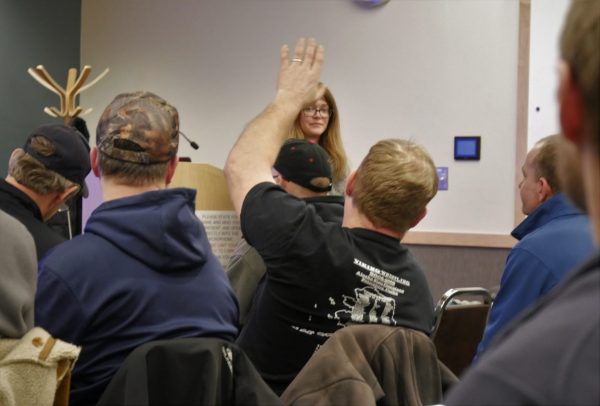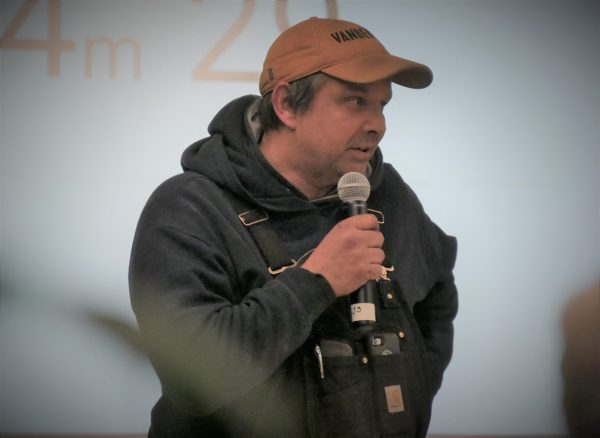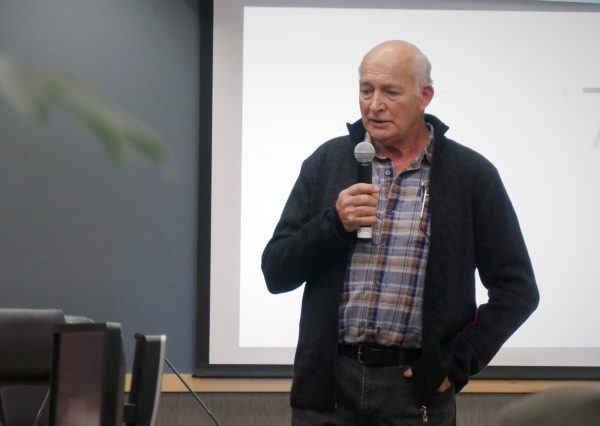
Fishermen from different gear groups united against a proposed federal rule to designate Southeast Alaska as critical habitat for humpback whales. Many of the fishermen voiced their opposition during a three-hour meeting hosted by the National Marine Fisheries Service in Petersburg Jan. 6.
About 60 people crowded into the Petersburg borough assembly chambers and others overflowed into the hallway. Most were fishermen from Petersburg, Wrangell, and Ketchikan. A group from Ketchikan also testified by phone.
They had the same message for the federal government. They don’t want Southeast labeled critical habitat for whales.
“It bothers all of us and I think it’s wrong,” said Chris Guggenbickler, a commercial gillnetter from Wrangell.
The meeting was run by Lisa Manning, with the National Marine Fisheries Service or NMFS. She spent about an hour trying to convince the crowd that a critical habitat designation would not affect commercial fisheries.
“It’s not conceivable to think that you’re going to do anything differently than what you’re doing now,” she said.
Although there are state managed herring fisheries, the federal government prohibits federal fisheries for the whales’ main prey species. Manning said protections are already high for the whales and fisheries would not be more restricted from the designation.

But attendees were not convinced.
“It makes me really nervous when the federal or the state decide to protect something that could affect our fisheries,” said Bud Samuelson, long-time Petersburg commercial fisherman
Amy Daugherty is the Executive Director of the Alaska Trollers Association based in Juneau. She said critical habitat means one step closer to restrictions for them.
“Something can go from threatened to endangered and all of a sudden things get crazy,” Daugherty said. “All of a sudden we get a low count and we’re S.O.L.”
NMFS must designate critical habitat for species listed under the Endangered Species Act. The agency is proposing the critical habitat rule now because two groups of humpback whales that travel to Alaska to feed are showing low numbers. There is an endangered group of 1,000 whales from the Western North Pacific that feeds near Bristol Bay and the Aleutian Islands. And there is a threatened group of about 2,800 humpbacks from Mexico that goes north along the west coast to feed. Just a small portion of them– between 56 and 238 whales travel as far north as Alaska. The proposed rule would designate 22,000 square nautical miles in Southeast as critical habitat and about 79,000 square nautical miles along the Bristol Bay and the Aleutian coastline.
But it’s hard for Southeast residents to see past all the whales in their backyard. There is also a robust population of humpbacks that number around 11,000, which migrate between Southeast for feeding and Hawaii for breeding.
Russell Cockrum, a commercial fisherman of 44 years from Ketchikan, said the growth in Southeast’s whale population has been too much.
“Now, it’s beyond ridiculous,” he said. “And I don’t know how this process started but it falls under the same verbiage, it’s ridiculous also.”
Long-time commercial salmon seiner and longliner, Sig Mathisen of Petersburg, said whales have been in Southeast for decades and the region is not to blame for any low numbers.

“I really feel Southeast Alaska for sure should be excluded from this critical habitat,” Mathisen said. “You’re talking about our whale population and any effect on it are happening somewhere else.”
There is a small area in Southeast proposed to be excluded from the designation for military reasons. There are two more areas in the western part of the state to be excluded due to economic impacts. Several fishermen at the Petersburg hearing asked if Southeast could also be excluded for that reason. One of them was Max Worhatch with the United Southeast Alaska Gillnetters, representing nearly 500 permit holders. He said the group disagrees with the economic analysis in the proposal and wants a new one.
“The costs are only figured for National Marine Fisheries Service to consider impacts to critical habitat,” Worhatch said. “There’s no consideration for other economic impacts to fishermen, processors and communities.”
Manning didn’t say whether they’d redo the economic analysis but she did say that an area can be excluded if the economic impact outweighs the conservation benefit.
She told the hearing attendees that critical habitat does not create preserves, sanctuaries, or closed areas. But it would make federal activities in the area more regulated—like projects or permitting through the Army Corps of Engineers including alternative energy projects. The rough timeline would have the designation activated by early November of this year. The public comment period ends Jan. 31.




